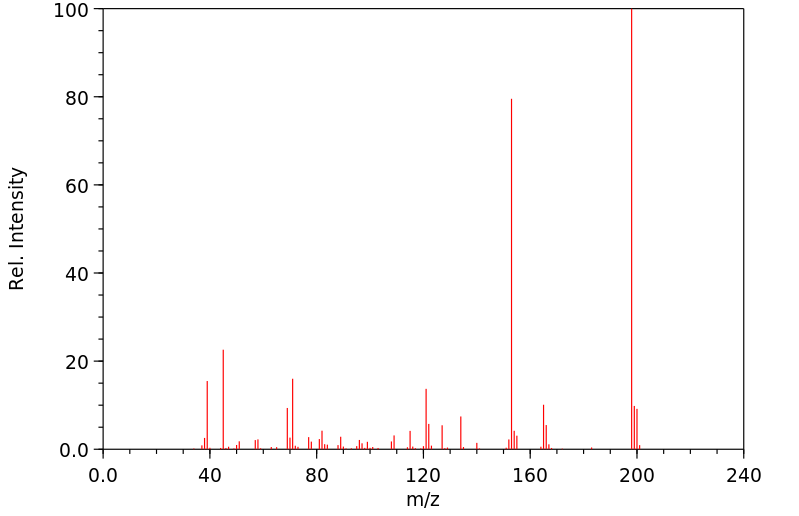di(thiophen-3-yl)sulfane | 3807-38-3
中文名称
——
中文别名
——
英文名称
di(thiophen-3-yl)sulfane
英文别名
di(3-thienyl) sulfide;3,3'-Dithienyl-sulfid;bis(3-thienyl) sulfide;Thiophene, 3,3'-thiobis-;3-thiophen-3-ylsulfanylthiophene
CAS
3807-38-3
化学式
C8H6S3
mdl
——
分子量
198.334
InChiKey
NNPKTEYAZSRKAG-UHFFFAOYSA-N
BEILSTEIN
——
EINECS
——
-
物化性质
-
计算性质
-
ADMET
-
安全信息
-
SDS
-
制备方法与用途
-
上下游信息
-
文献信息
-
表征谱图
-
同类化合物
-
相关功能分类
-
相关结构分类
物化性质
-
沸点:115 °C(Press: 0.4 Torr)
-
密度:1.37±0.1 g/cm3(Predicted)
计算性质
-
辛醇/水分配系数(LogP):3.4
-
重原子数:11
-
可旋转键数:2
-
环数:2.0
-
sp3杂化的碳原子比例:0.0
-
拓扑面积:81.8
-
氢给体数:0
-
氢受体数:3
安全信息
-
海关编码:2934999090
SDS
上下游信息
-
下游产品
中文名称 英文名称 CAS号 化学式 分子量 —— dibromo-2,2' sulfure de dithienyle-3,3' 65827-99-8 C8H4Br2S3 356.126
反应信息
-
作为反应物:描述:di(thiophen-3-yl)sulfane 在 正丁基锂 、 copper dichloride 作用下, 以 乙醚 为溶剂, 反应 1.0h, 以41%的产率得到二噻吩[3,2-B:2',3'-D]噻吩参考文献:名称:电子化噻吩杯[n]二硫代噻吩的有效合成,结构和络合研究摘要:通过简便的方法制备了一系列噻唑烷[n]二硫代噻吩(n = 4-10),并使用X射线分析确定了正方形(4聚体)和五边形大环(5聚体)的分子结构。 )。在循环伏安图中,在低氧化电位下观察到由于电子离域而引起的可逆多电子氧化还原过程。环状4聚体充当两个C 60分子的“ Janus头”空洞,而5和6聚体与C 60形成稳定的1:1络合物 。DOI:10.1002/anie.201410970
-
作为产物:描述:3-碘噻吩 在 potassium thioacyanate 、 copper(II) oxide 、 potassium hydroxide 作用下, 以 二甲基亚砜 为溶剂, 反应 20.0h, 以62%的产率得到di(thiophen-3-yl)sulfane参考文献:名称:在无配体条件下纳米氧化铜催化对称二芳基硫化物的合成。摘要:在无配体条件下,由可回收氧化铜纳米粒子介导的 CS 交叉偶联反应中,硫氰酸钾充当有效的硫替代物。该协议避免了难闻的硫醇,用于合成各种对称的二芳基硫化物,通过不同的芳基卤化物与硫氰酸钾的交叉偶联,以中等至优异的产率提供相应的产品。DOI:10.3762/bjoc.7.101
文献信息
-
Copper oxide nanoparticles catalyzed synthesis of aryl sulfides via cascade reaction of aryl halides with thiourea作者:K. Harsha Vardhan Reddy、V. Prakash Reddy、J. Shankar、B. Madhav、B.S.P. Anil Kumar、Y.V.D. NageswarDOI:10.1016/j.tetlet.2011.03.070日期:2011.5and highly efficient protocol for the synthesis of symmetrical aryl sulfides was developed by the cross-coupling of aromatic halides with inexpensive and commercially available thiourea which was used as an effective sulfur surrogate. The present cross-coupling protocol of thiourea, via cascade reaction with various substituted aryl halides, producing desired aryl sulfides, has an added advantage of
-
Rhodium-catalyzed odorless synthesis of diaryl sulfides from borylarenes and S-aryl thiosulfonates作者:Kazuya Kanemoto、Yasuyuki Sugimura、Shigeomi Shimizu、Suguru Yoshida、Takamitsu HosoyaDOI:10.1039/c7cc05868c日期:——Various diaryl sulfides, including heteroaryl- and nitrogen-containing sulfides, have been efficiently prepared by rhodium-catalyzed odorless deborylative arylthiolation of organoborons with S-aryl thiosulfonates. The ready availability of starting materials and further transformation of sulfides have rendered a diverse range of organosulfur compounds easily accessible.
-
High surface and magnetically recoverable mPANI/pFe<sub>3</sub>O<sub>4</sub>nanocomposites for C–S bond formation in water作者:D. Damodara、R. Arundhathi、Pravin R. LikharDOI:10.1039/c2cy20624b日期:——A high surface area mPANI/pFe3O4 nanocomposite from mesoporous polyaniline and porous magnetic Fe3O4 was used as a catalyst in the S-arylation of thiophenol with aryl chlorides and in the C–S bond formation between aryl iodides and thiourea in water. The mesoporosity of the polyaniline enhances the efficiency and stability of the porous magnetic Fe3O4 nanoparticles in both coupling reactions. The mPANI/pFe3O4
-
Thiophenes as Traps for Benzyne. 3. Diaryl Sulfides and the Role of Dipolar Intermediates作者:Manfred G. Reinecke、Dario Del Mazza、Marcus ObengDOI:10.1021/jo0265176日期:2003.1.1mechanisms of formation. The remaining mechanism involves [4+2]-cycloaddition of benzyne to thiophene or to an S-phenylthiophenium ylide 10 to give the dipolar 2:1 benzyne/thiophene adduct 8 followed by ring-opening. Stevens-like rearrangements of 11, formed from 10 by proton transfer, may also explain the origin of arylated thiophenes such as 12 and 3 found in some reactions of benzynes with thiophene.
-
Synthesis of Thieno[3,2-<i>b</i>]benzofurans by Palladium-catalyzed Intramolecular C–H/C–H Coupling作者:Hiroyuki Kaida、Tetsuya Satoh、Koji Hirano、Masahiro MiuraDOI:10.1246/cl.150408日期:2015.8.5The intramolecular C–H/C–H coupling of 3-aryloxythiophenes and 3-aryloxybenzo[b]thiophenes has been found to occur effectively in the presence of Pd(TFA)2 and AgOAc as catalyst and oxidant, respect...
表征谱图
-
氢谱1HNMR
-
质谱MS
-
碳谱13CNMR
-
红外IR
-
拉曼Raman
-
峰位数据
-
峰位匹配
-
表征信息
同类化合物
(Rp)-2-(叔丁硫基)-1-(二苯基膦基)二茂铁
(1E)-1-{4-[(4-氨基苯基)硫烷基]苯基}乙酮肟
颜料红88
颜料紫36
顺式-1,2-二(乙硫基)-1-丙烯
非班太尔-D6
雷西那得中间体
阿西替尼杂质J
阿西替尼杂质C
阿西替尼杂质4
阿西替尼杂质
阿西替尼
阿拉氟韦
阿扎毒素
阿嗪米特
阔草特
银(I)(6-氨基-2-(甲硫基)-5-亚硝基嘧啶-4-基)酰胺水合物
钾三氟[3-(苯基硫基)丙基]硼酸酯(1-)
邻甲苯基(对甲苯基)硫化物
避虫醇
连翘脂苷B
还原红 41
还原紫3
还原桃红R
达索尼兴
辛硫醚
辛-1,7-二炔-1-基(苯基)硫烷
西嗪草酮
萘,2-[(2,3-二甲基苯基)硫代]-
莫他哌那非
茴香硫醚
苯醌B
苯酰胺,N-(氨基亚氨基甲基)-4-[(2-甲基苯基)硫代]-3-(甲磺酰)-,盐酸盐
苯酰胺,N-(氨基亚氨基甲基)-4-[(2-氯苯基)硫代]-3-(甲磺酰)-,盐酸盐
苯酰胺,N-(氨基亚氨基甲基)-4-[(2,6-二氯苯基)硫代]-3-(甲磺酰)-,盐酸盐
苯酰胺,2-[(2-硝基苯基)硫代]-
苯酚,3-氯-4-[(4-硝基苯基)硫代]-
苯酚,3-(乙硫基)-
苯酚,3,5-二[(苯基硫代)甲基]-
苯胺,4-[5-溴-3-[4-(甲硫基)苯基]-2-噻嗯基]-
苯胺,3-氯-4-[(1-甲基-1H-咪唑-2-基)硫代]-
苯胺,2-[(2-吡啶基甲基)硫代]-
苯硫醚-D10
苯硫胍
苯硫基乙酸
苯硫代磺酸S-(三氯乙烯基)酯
苯甲醇,2,3,4,5,6-五氟-a-[(苯基硫代)甲基]-,(R)-
苯甲酸,3-[[2-[(二甲氨基)甲基]苯基]硫代]-,盐酸
苯甲胺,5-氟-2-((3-甲氧苯基)硫代)-N,N-二甲基-,盐酸
苯甲二硫酸,4-溴苯基酯







